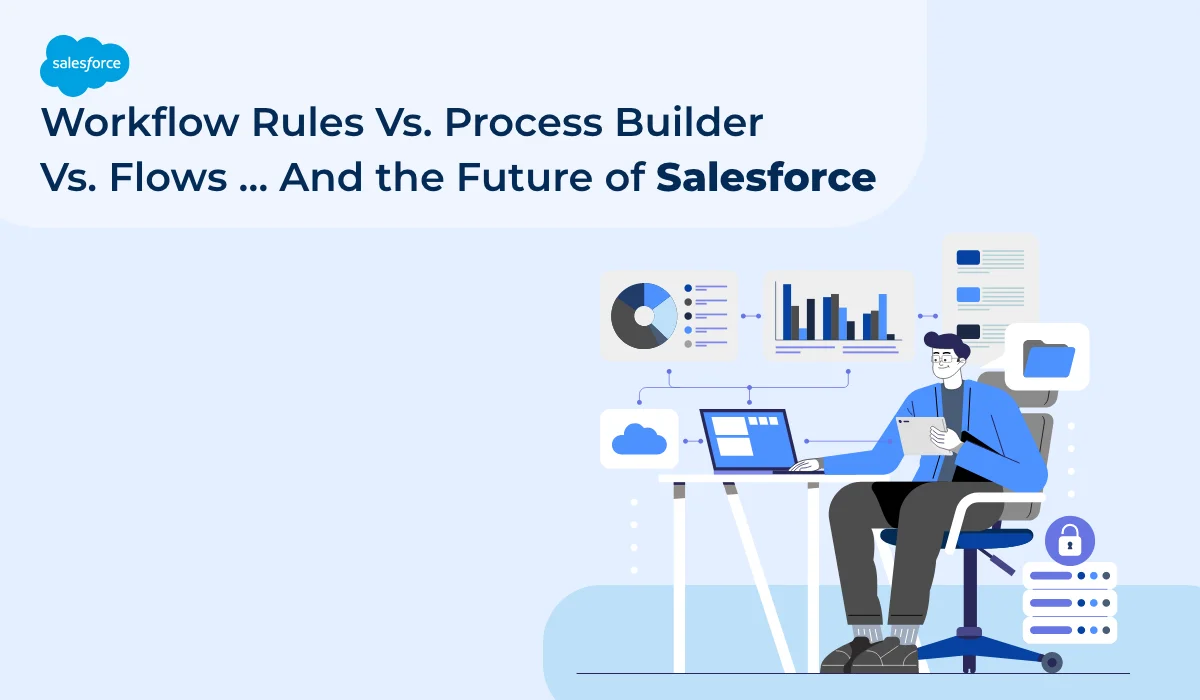Salesforce Workflow Rules vs Process Builder vs Flows: Which to Use?

Published on: September 14, 2022
Updated on: March 04, 2025
4816 Views
- Salesforce
8 min read
It is a common sentiment among business owners that complex business processes should be converted into simple and actionable icons or buttons. Salesforce admins are always looking for ways to substitute complex code using a variety of Salesforce development tools.
In this post, we will look at different ways of creating smart workflows in Salesforce that make the life of Salesforce admins a lot easier and give them the capability to rival Salesforce developers.
What are the differences between Workflow Rules, Process Builder, and Flows in Salesforce?
In Salesforce, Workflow Rules, Process Builder, and Flows each offer distinct capabilities for automating business processes. Workflow Rules are the simplest automation tool, suitable for straightforward, rule-based tasks like sending email alerts or updating fields. Process Builder provides more flexibility with a visual interface for designing complex automation, including multiple criteria and actions, and supports a wider range of processes than Workflow Rules. Flows are the most powerful and versatile, allowing for intricate logic, user interactions, and complex data manipulation through a drag-and-drop interface. Flows can handle scenarios beyond the capabilities of Workflow Rules and Process Builder, such as multi-step processes and integrations with external systems.
But before we get into the details, here is a quick recap of some essential concepts.
What Is Workflow?
Let’s start from the basics. Workflow is a sequence of tasks used to process a data set. They are present across different industries and are created whenever data is exchanged between systems and humans. Simply put, they are paths that describe the progress of a task, for example, if it is pending, done, or in progress.
Workflow automates standard procedures and processes to help your organization save a ton of time. A workflow rule is a primary container for set workflow instructions. These instructions or rules are often contained in an if/then statement.
For example, ‘If an employee is sick, then they must stay home.’
In this example, the Workflow is divided into two components. First, the ‘if’ part of the workflow must be true to execute the secondary actions. Second, the ‘then’ part of the workflow describes what an employee should do if the first part of the workflow is true.
Limitations of Workflow
Part 1: For each workflow rule:
- You can only have 10-time triggers for every workflow rule
- It is not possible to exceed 40 immediate actions
- You only get access to 40 time-dependent actions for each time trigger
Part 2: For both time-dependent and immediate actions in workflow rule:
- You only get ten email alerts
- The number of tasks is restricted to 10
- You can only have ten field updates
- The number of outbound messages is limited to 10
Part 3: Workflow time trigger limit for different editions (hourly):
- Professional: 250
- Enterprise: 500
- Developer: 50
- Unlimited and Professional: 1000
Part 4: Daily email limit for Workflow:
- With Standard Salesforce license: 1000
- For every organization: 200,000
The next automation tool on the list is Process Builder. But before we dive into the details, here is a quick recap.
What Is a Process Builder?
It is a Salesforce automation tool that enables you to manage and control the order of actions or analyze the criteria for records in the system. It also allows you to use the if/then logic to automate your current Salesforce environment. Process Builder consists of a triggering event, followed by a secondary action that will take place.
For example, If a user creates a new record based on the predefined criteria, then the system will initiate an action.
A technical business analyst or Salesforce admin can use the tool's ‘point and click capability from Process Builder UI to automate tasks easily. However, it still doesn’t match the ‘bells and whistles as Flows.
Limitations of Process Builder
- Every Process Builder only relates to a single object set up by you
- You will only be able to use child objects in relation to the primary triggering object
- It doesn’t allow you to delete records
- You might not be able to complete any complex actions
- The actions are evaluated in the order of their appearance in Process Builder
Read More: Salesforce Flow: The Future Of Salesforce
Difference Between Process Builder and Workflow Rules
Automating business processes can make an app legitimately useful, and a tech-savvy admin can save time while creating consistent processes. While Workflow Rules is the original tool, Process Builder brought new changes with its visual interface for mapping automation.
Here are the key differences between the two.
Comparison of Workflow Rules and Process Builder
| Workflow Rules | Process Builder |
|---|---|
| It is used to update a field | You can create new tasks easily. |
| It is a good tool for sending outbound messages | It comes with decent features for sending emails |
| It helps you create records and edit tasks. | It is easy to update all related records |
| You can launch a Quick Action | It is capable of launching a flow |
| you can easily Call Apex Code | It lets you Post to Chatter |
| It enables easy submission for approval | you can invoke other processes easily |
